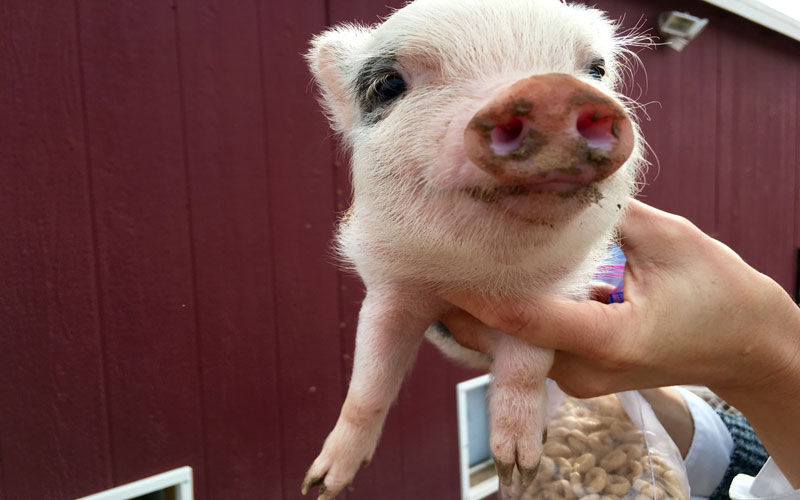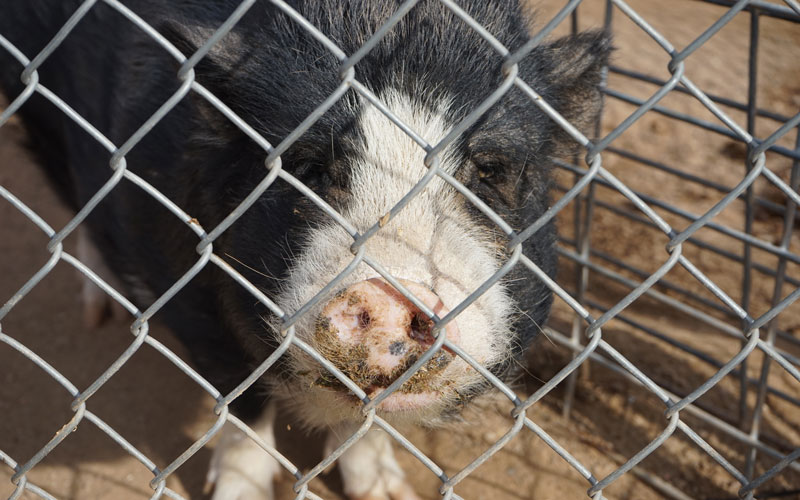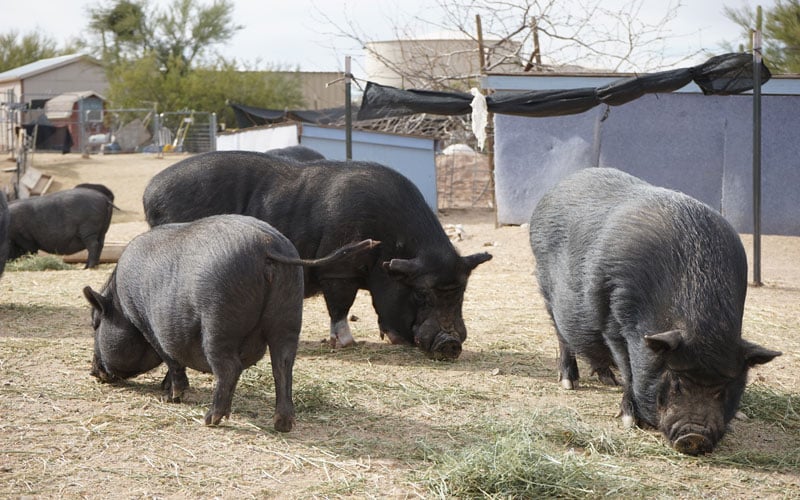
Ashley Aakre, an American Mini Pig Association breeder and owner of Lil’ Smokie Julianas, holds up a mini pig. This pig is 6 to 8 weeks old, which is when breeders usually sell them.
(Photo by Lauren Michaels/Cronkite News)

The Ironwood Pig Sanctuary in Marana houses pigs like this one. A rising number of pigs at the sanctuary were sold as miniature pigs but outgrew their promised size, said Mary Schanz.
(Photo by Travis Arbon/Cronkite News)

Mary Schanz, co-founder and president of the nonprofit sanctuary Ironwood Pig Sanctuary in Marana, gives an animal cracker to a pig.
(Photo by Travis Arbon/Cronkite News)

Pigs engage in behaviors such as rooting and digging that can be destructive to indoor environments, which is why Mary Schanz, recommends they be given outdoor spaces.
(Photo by Travis Arbon/Cronkite News)
MARANA — Oatis the piglet was smaller than Bryanna Tinsley’s head when she purchased and shipped him from Texas. Tinsley said the pig now weighs about 120 pounds.
Tinsley, who lives in Avondale, is one of many people who have purchased “miniature” pigs as pets under the impression they would remain relatively small. And she feels duped.
Because the government only lightly regulates the sale of the animals, it’s difficult to track just how many people share her experience.
When the animals grow to nearly 200 pounds and start digging, biting and needing expensive medical care, some customers find themselves overwhelmed. Tinsley said when Oatis got bored, he would tear up her tile and carpet and tried to knock over her fence, adding to the cost of a pet for which she paid about $1,000.
“(The breeder) was telling me that they didn’t grow more than 30 to 35 pounds – the biggest pig was probably about 40 pounds – and they had to follow a certain diet and certain exercise,” Tinsley said. “I was told that they would be fine, that they would be flown out to me and they would never grow bigger than a certain weight, which is wrong because he grew to be pretty large.”
That’s because “miniature pig” is a misnomer. By and large, these are regular potbelly pigs rebranded as an exotic diminutive species, one Arizona pig advocate said.
After five years, Tinsley could no longer care for Oatis at her home, so she moved him to Ironwood Pig Sanctuary in Marana, an institution that cares for pigs without owners. Ironwood is the only pig sanctuary in Arizona.
Mary Schanz, co-founder and president of the nonprofit sanctuary, said that over the last year, she’s seen a rise in the number of pigs donated by people who believed they were buying “mini” pigs.
Ironwood houses more than 500 pigs on about 20 acres. Many of the pigs have special dietary or medical needs. Schanz said most pigs come to the sanctuary after a move or divorce by the owners, but that trend is changing.
“This past year, almost all the pigs we are getting are either strays … or people calling us that have gotten a pig, and they had no idea what they were getting,” Schanz said. “They were told it was going to be a micro-mini pig, and it has gotten too big. That is about the only reason we are getting pigs this year.”
She said breeders continue to produce pigs even if there isn’t enough demand to meet the supply.
Some businesses start breeding pigs the moment they become fertile to show customers how small the parents are, despite the dangers of pregnancy for pigs that young, Schanz said. Tactics used to keep pigs small and more marketable, such as underfeeding, can lead to organ failure and early deaths, she said.
“They tell them to feed them a quarter-cup a day, an eighth-cup in the morning an eighth-cup at night and a few vegetables,” Schanz said. “They’re literally starving these animals to death.”
Tinsley said she took Oatis to a veterinarian after he arrived from Texas. The veterinarian told her the pig was malnourished, dehydrated and had two ear infections. The veterinarian recommended Tinsley feed Oatis more than the breeder had told her.
Felicia Thompson, a spokeswoman for the Better Business Bureau of Arizona, said the organization could not find any complaints related to “mini” pig breeders.
In the absence of government regulation, some pig breeders across the country organized to attempt to impose restraints by forming the American Mini Pig Association. The Idaho-based group accredits breeders who conform to its standards and register their pigs.
While many businesses in Arizona claim to offer “mini” pigs, only one is registered with the association, Lil’ Smokies Julianas in Queen Creek, according to the group’s website. The owner, Ashley Aakre, said she recommends her customers do research before buying a pig.
“What I always say is don’t believe any breeder, not even me,” Aakre said. “What you should do is find an independent, third-party regulation authority like the American Mini Pig Association or the Breeder’s Co-Op and do your research there. I mean, find an association that is focused on education and helping miniature pig breeders be more educated.”
But breeders still sell pigs to customers who may not fully understand the implications of ownership.
Schanz said the sanctuary doesn’t adopt out pigs to people who can’t afford to take care of them or plan to keep them in an apartment. She said it can cost between $400 and $700 to spay or neuter the pigs. Pigs also require checkups and regular medical attention, such as tusk trims, that only certain veterinarians can perform. The entire process can overwhelm an unprepared owner, she said.
Despite growing beyond what she expected, Tinsley said she still wants to find a way to care for Oatis in the future.
“It took me five years to be able to let it go, and I still haven’t let it go,” Tinsley said. “I still am trying really hard to be able to get him back. I know he’s somewhere safe, and I know he’s being taken care of, but it’s hard because you get attached to them. They’re like you’re family and your children.”